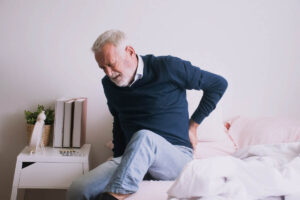Do you experience pain in the lowest part of your back when walking? If so, you’re not alone. Millions of people deal with lower back pain, especially when performing activities like hiking or walking. This type of pain, often located in the lower part of the spine, can range from mild discomfort to debilitating agony. Whether it’s caused by a herniated disc, muscle strain, or a more serious condition like degenerative disc disease, understanding the root cause is the first step in finding relief. In this article, we’ll explore common causes of lower back pain when walking and provide actionable treatment tips, including how to relieve bottom back pain and when to seek professional help.
What is Lower Back Pain?
Lower back pain refers to discomfort or pain in the lumbar region, located at the bottom of the back. This pain can be sharp, dull, or even a scorching and stabbing feeling depending on the underlying issue. Lower back pain can occur during various activities, especially when walking, which puts additional stress on the spine and the surrounding muscles.
Lower back pain when hiking or walking is a common complaint and can be attributed to numerous conditions. This type of pain can interfere with your daily life, making simple movements uncomfortable. Whether it’s from poor posture, muscle weakness, muscle imbalance, or being overweight or out of shape; addressing the pain early can prevent it from becoming a chronic issue.
Causes of Lower Back Pain
Studies have indicated that nearly a quarter of the global adult population experiences chronic low back pain, with recurrence rates ranging between 24% and 80% within a year. Chronic bottom back pain, especially when walking, can significantly impact daily functioning, making early intervention crucial to preventing long-term discomfort.
Lower back pain, can arise from several sources. Here are the most common causes:
Strains and Sprains
One of the most common causes of lower back pain, is muscle strain. These injuries can happen from improper lifting, overexertion, or even from prolonged standing and repetitive movements. Muscle fatigue is often associated with overuse, leading to muscle tension and soreness in the lower back.
Disk Problems
Degenerative disc disease and herniated or bulging discs are common sources of lower back pain. The spine’s discs act as cushions between the vertebrae, and when they deteriorate or herniate, they can press on nearby nerves. This can cause radiating pain that worsens when walking. People with degenerative disc disease often experience a loss of flexibility and chronic pain.
Structural Issues
Structural problems like excessive lordosis or scoliosis can place abnormal stress on the lumbar spine, leading to discomfort. Excessive lordosis is an exaggerated inward curve of the lower spine, causing bottom back pain that becomes more pronounced with walking or standing for long periods.
Arthritis
Conditions such as osteoarthritis and ankylosing spondylitis cause joint inflammation and can severely affect the spine, leading to pain when moving. In ankylosing spondylitis, the spinal joints become inflamed, causing stiffness, pain, and sometimes immobility.
Movement disorders
Most frequently, abnormal movement patterns originating from the hips or low back are the most frequent cause for recurrent low back pain. Ensuring good alignment and proper muscle performance throughout the low back and into the legs, is crucial.
Other Temporary Causes of Low Back Pain
In addition to chronic conditions, several temporary factors can cause bottom of back pain when walking.
Menstrual Cramps
Menstrual cramps can cause radiating lower back pain that worsens when walking. This is often due to the uterus contracting and affecting the surrounding muscles.
Pregnancy
Pregnant women frequently experience bottom back pain due to the added weight and excessive lordosis caused by the growing baby. As the pregnancy progresses, the center of gravity shifts, placing additional strain on the lower back muscles.
Back Labor
During labor, some women experience back labor, which involves intense pain in the lower back and bottom region, especially when walking or standing.
Why Do I Have Lower Back Pain When Walking?

If you’re wondering why you have pain in the bottom of your back when walking, various factors could be responsible. Here’s a closer look:
For the majority of individuals suffering from lower back pain, the issue is acute rather than chronic. In fact, around 9 out of 10 patients experience acute back pain, which typically resolves within a few days or weeks with proper rest and care. Acute pain is often due to minor issues like muscle strain, poor posture, or overexertion.
1. Muscle Fatigue
Walking for extended periods without proper conditioning can lead to muscle fatigue, especially in the core muscles and lower back. This fatigue can cause the muscles to become tight and sore, leading to bottom back pain.
2. Muscle imbalances
Excessive lordosis, an exaggerated inward curvature of the spine, can cause discomfort when walking. This most frequently occurs when the muscles of the hips are weak, the abdominals are weak, the hamstrings are tight, and the low back musculature is overworked trying to compensate for the weak hips.
3. Pulled Muscles, Sprains, and Strains
A muscle strain or ligament sprain can occur from something as simple as twisting the wrong way or overextending during a workout. These injuries cause swelling and inflammation, leading to bottom back pain when walking.
4. Spinal Stenosis
Spinal stenosis is the narrowing of the spinal canal, putting pressure on the spinal cord and nerves. This can lead to numbness, tingling, or radiating pain in the lower back and legs, which often worsens with walking.
5. Sciatica
When the sciatic nerve is compressed due to conditions like a herniated disc or spinal stenosis, it causes sciatica, leading to pain that radiates from the lower back down the leg. Walking can aggravate this pain, causing a burning or shooting sensation.
6. Degenerative Disc Disease
As the spinal discs wear down over time, they lose their cushioning ability. This condition, known as degenerative disc disease, can cause mechanical lower back pain, especially during movement like walking.
Treatment for Lower Back Pain
Effectively treating bottom back pain requires addressing the underlying cause. Here are several treatment options:
Medications
Over-the-counter nonsteroidal anti-inflammatory medications (NSAIDs) such as ibuprofen can help reduce inflammation and relieve pain. In more severe cases, doctors may prescribe muscle relaxers or lumbar epidural steroid injections to provide targeted relief.
Physical Therapy (PT)
Physical therapy focuses on improving flexibility, core strength, and posture to alleviate bottom back pain. PT may include pilates, core-strengthening exercises, and dynamic postural control exercises to support the spine better. Therapists may also recommend incorporating movement snacks throughout the day to prevent prolonged periods of inactivity, which contribute to muscle fatigue.
Hands-on Manipulation
Chiropractic adjustments and osteopathic manipulation can help realign the spine, providing relief from mechanical issues such as excessive lordosis or sciatica.
Injections
For patients with severe inflammation, lumbar epidural steroid injections may be administered directly into the spine to provide significant pain relief and reduce swelling.
Diagnosis and Tests
To identify the root cause of bottom back pain, a physical exam and various tests may be conducted:
Spine X-ray
A spine X-ray provides detailed images of the bones, helping to identify fractures, tumors, or structural problems contributing to the pain.
MRI
An MRI scan offers a detailed look at the soft tissues in the spine, revealing issues such as a herniated disc, bulging disc, or spinal tumors.
CT Scan
A CT scan may be ordered to provide more detailed images of the spine, helping to detect conditions like spinal stenosis or fractures.
Electromyography (EMG)
EMG measures electrical activity in the muscles and can be used to diagnose conditions that affect the nerves, such as sciatica.
How Can I Prevent Lower Back Pain?
Preventing bottom back pain involves several lifestyle changes that can promote better spine health:
Adjust Your Workstation
Ensure your desk setup is ergonomic to reduce strain on the spine, as improper posture can lead to bottom back pain.
Exercise and Stretch
Regular physical activity, such as walking or brisk walking(a.k.a Nordic Walking), can be highly beneficial in managing lower back pain. Engaging in a 30- to 60-minute walk every two days helps strengthen the core muscles, improves flexibility, and may reduce discomfort in the bottom of the back when walking. Consistency is key to experiencing long-term relief.
Engaging in regular exercise and stretching activities can strengthen the core muscles, supporting the spine and reducing the risk of injury. Pilates, yoga, and dynamic postural control exercises are particularly beneficial for maintaining a healthy spine.
Mind Your Posture
Maintaining good walking posture is essential to prevent bottom back pain. Avoid slouching and keep your spine aligned to reduce stress on the lower back.
Lose Weight

Excess weight, particularly around the abdomen, can put additional stress on the lower back, leading to pain. Maintaining a healthy weight through a nutritious diet and regular exercise can help alleviate this pressure.
Stay fit and active
Staying strong, flexible, and performing at your best is the best way to keep low back pain at bay. Proper muscle balance and performance with whatever activity you enjoy most is of the utmost importance.
If You’re Experiencing Back Pain, Let Us Help You
If you’re struggling with persistent lower back pain, it’s crucial to seek professional guidance. A healthcare provider can assess your condition, offer appropriate treatments, and help you regain mobility. Don’t suffer in silence—reach out for support and get back to enjoying your daily activities.
At Austin Manual Therapy Associates, we specialize in personalized care for individuals experiencing back pain, helping you regain mobility and live pain-free. Our highly skilled therapists focus on identifying the root causes of your discomfort, offering tailored physical therapy exercises for lower back pain designed to strengthen core muscles, improve posture, and reduce pain. Whether you’re dealing with chronic conditions like degenerative disc disease or acute injuries, our hands-on techniques and evidence-based treatments provide effective relief, empowering you to take control of your recovery. Let us help you get back to doing the things you love, pain-free.
Conclusion
Lower back pain when walking can be frustrating and debilitating, but with the right knowledge and treatment, relief is within reach. Whether it’s caused by muscle fatigue, spinal issues, or temporary conditions, addressing the problem early on can help you get back to feeling your best.
FAQs
What causes lower back pain when walking?
Lower back pain when walking can be caused by various factors, including muscle fatigue, muscle imbalances, spinal misalignment, sciatica, and degenerative disc disease.
How can I relieve lower back pain when walking?
You can relieve lower back pain by practicing good walking posture, wearing supportive shoes, stretching regularly, and seeking professional treatment for more severe issues.
When should I see a doctor for lower back pain?
You should see a doctor if your pain is severe, lasts longer than a few weeks, or is accompanied by other symptoms such as numbness, weakness, or difficulty walking.





